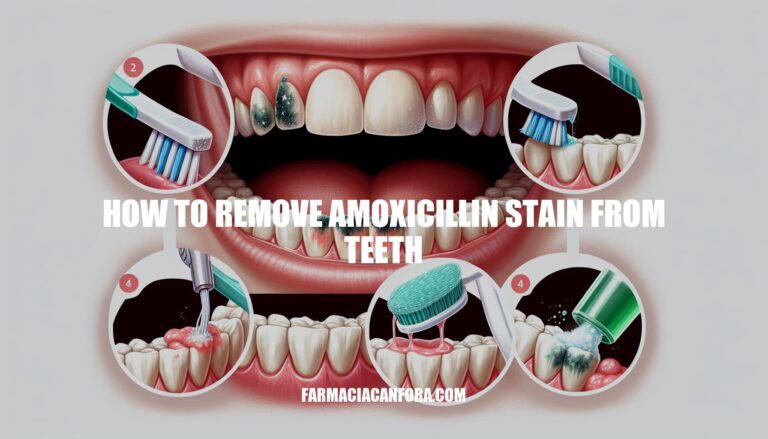Amoxicillin, a commonly prescribed antibiotic, can sometimes cause brown, yellow, or gray stains on teeth, particularly in children. These stains occur when the liquid form of the medication interacts with the tooth surface, leading to extrinsic discoloration. Addressing these stains is important for maintaining oral hygiene and aesthetics, as they can be removed with proper brushing and professional dental cleanings. Regular dental visits help ensure that any discoloration is promptly treated, preserving the health and appearance of your teeth.
Causes of Amoxicillin Stains on Teeth
Amoxicillin can cause teeth staining due to its interaction with dental plaque and enamel. The staining is often linked to the liquid form of amoxicillin, which is more commonly prescribed to children. Here are the specific reasons:
- Chemical Interactions: Amoxicillin contains chromogens, which are substances that can convert into colored compounds. These chromogens can bind to the proteins in the tooth enamel, leading to discoloration.
- Plaque Interaction: When amoxicillin interacts with dental plaque, it can form colored complexes that adhere to the tooth surface, causing extrinsic stains.
- Forms of Amoxicillin: The liquid form of amoxicillin is more likely to cause staining compared to tablets or capsules. This is because the liquid form can linger on the teeth longer, increasing the chance of chromogen interaction with the enamel.
Preventive Measures
Here are some steps to prevent amoxicillin stains on teeth:
- Brush twice daily with a whitening toothpaste, preferably one containing hydrogen peroxide.
- Brush after taking the medication to reduce the chances of it staying on your teeth.
- Floss and rinse daily to maintain overall oral hygiene.
- Avoid stain-inducing foods and drinks like tea, cola, and juices while on the medication.
- Opt for pill or capsule forms of amoxicillin instead of liquid forms, if possible.
- Regular dental cleanings to remove any potential stains.
- Consult your doctor about alternative medications if staining is a concern.
These practices can help keep your teeth stain-free while taking amoxicillin.
Home Remedies for Removing Amoxicillin Stains
Here are some effective home remedies for removing amoxicillin stains from teeth:
-
Baking Soda and Hydrogen Peroxide:
- Mix a small amount of baking soda with hydrogen peroxide to form a paste.
- Apply the paste to your toothbrush and brush your teeth gently for 2 minutes.
- Rinse thoroughly with water.
-
Baking Soda and Water:
- Mix baking soda with a small amount of water to create a paste.
- Brush your teeth with the paste for 2 minutes.
- Rinse well with water.
-
Hydrogen Peroxide Mouthwash:
- Dilute hydrogen peroxide with an equal amount of water.
- Swish the solution in your mouth for 1 minute.
- Spit it out and rinse your mouth with water.
-
Apple Cider Vinegar:
- Dilute apple cider vinegar with water (1 part vinegar to 2 parts water).
- Swish the solution in your mouth for 1 minute.
- Rinse thoroughly with water.
-
Activated Charcoal:
- Wet your toothbrush and dip it into activated charcoal powder.
- Brush your teeth gently for 2 minutes.
- Rinse well with water.
-
Coconut Oil Pulling:
- Swish a tablespoon of coconut oil in your mouth for 15-20 minutes.
- Spit it out and rinse your mouth with water.
-
Strawberries and Baking Soda:
- Mash a ripe strawberry and mix it with baking soda to form a paste.
- Apply the paste to your teeth and leave it on for 5 minutes.
- Brush your teeth and rinse thoroughly with water.
These remedies can help reduce the appearance of amoxicillin stains on your teeth. Remember to maintain good oral hygiene and consult your dentist for persistent stains.
Professional Dental Treatments
Here are some professional dental treatments for removing amoxicillin stains from teeth:
- Professional Cleanings: Dentists use specialized tools to remove surface stains through scaling and polishing.
- Whitening Treatments: In-office bleaching with hydrogen peroxide or carbamide peroxide can lighten stains. Custom-fitted take-home whitening kits are also effective.
- Microabrasion: This technique involves removing a thin layer of enamel to eliminate surface stains.
- Veneers: Thin porcelain or composite resin shells are bonded to the front of the teeth to cover deep stains.
- Bonding: A tooth-colored resin is applied and hardened with a special light to cover stains.
These treatments can effectively address amoxicillin stains and improve the appearance of your teeth.
Amoxicillin Stains on Teeth: Causes, Prevention, and Removal
Amoxicillin, a commonly prescribed antibiotic, can cause brown, yellow, or gray stains on teeth due to its interaction with dental plaque and enamel. These stains are more likely to occur in children who take the liquid form of the medication.
To prevent staining, it is recommended to:
- Brush twice daily with a whitening toothpaste
- Brush after taking the medication
- Floss and rinse daily
- Avoid stain-inducing foods and drinks
- Opt for pill or capsule forms instead of liquid forms
- Schedule regular dental cleanings
If stains do occur, there are several home remedies and professional dental treatments available to remove them, including:
- Baking soda and hydrogen peroxide paste
- Activated charcoal
- Coconut oil pulling
- Strawberries and baking soda
In addition to these home remedies, there are also several professional dental treatments available, such as:
- In-office bleaching
- Scaling and polishing
- Microabrasion
- Veneers
- Bonding
Addressing amoxicillin stains is crucial for maintaining oral hygiene and aesthetics, as they can be removed with proper brushing and professional dental cleanings.


